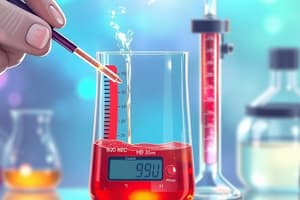Podcast
Questions and Answers
What does a pH meter measure?
What does a pH meter measure?
- The volume of a solution
- The mass of a solution
- The hydrogen-ion activity (correct)
- The temperature of a solution
What pH value indicates a neutral solution?
What pH value indicates a neutral solution?
- 0
- 7 (correct)
- 14
- 1
Which of the following is a component of a pH meter?
Which of the following is a component of a pH meter?
- Barometer
- Tachometer
- Spectrometer
- Glass Electrode (correct)
Flashcards
What is a pH meter?
What is a pH meter?
A scientific instrument that measures the hydrogen-ion activity in water-based solutions, indicating acidity or alkalinity, expressed as pH.
What does pH measure?
What does pH measure?
The degree of acidity or alkalinity of a solution, measured on a scale from 0 to 14.
What is a titration?
What is a titration?
It is a technique used to determine the concentration of an unknown acid or base.
Study Notes
- A pH meter is a scientific instrument used to measure hydrogen-ion activity
- The pH meter indicates acidity or alkalinity in water-based solutions
- Acidity or alkalinity is expressed as pH
- The pH meter measures the difference in electrical potential between a pH electrode and a reference electrode
- A pH meter is referred to as a "potentiometric pH meter"
- pHis the unit of measure describing the degree of acidity or alkalinity
- pH is measured on a scale from 0 to 14
- The pH meter scale ranges from 0 to 14
- Material is acidic if the concentration of H⁺ is greater than the concentration of OH⁻
- An acidic pH value is less than 7
- Material is neutral if the concentration of H⁺ is equal to OH⁻
- A neutral pH value is 7
- Material is basic if the concentration of H⁺ is less than OH⁻
- A basic pH value is greater than 7
- pH equals the negative logarithm of hydrogen ion concentration expressed in molarity
Formula for pH
- pH = -log[H⁺]
Main components
- A pH meter consists of a glass electrode, a reference electrode, and an electrometer
Glass Electrode
- A glass electrode consists of a very thin bulb, about 0.1 mm thick
- The thin bulb is blown onto a hard glass tube of high resistance
- The bulb contains 0.1 mol/litre of HCl
- The HCL connects to a platinum wire via a silver-silver chloride combination
Reference Electrode (Calomel Electrode)
- A reference electrode has a stable and well-known electrode potential
- It is a glass tube containing saturated KCl connected to platinum wires
- The platinum wires run through mercury-mercurous chloride paste
Electrometer
- An electrometer measures very small differences in electrical potentials
- It does this in a circuit of extremely high resistance
pH calibration
- A pH meter should be calibrated before each measurement for precise work.
- Calibration should be performed with at least two standard buffer solutions
- The standard buffer solutions span the pH values to be measured
- General purpose buffers should be standard at pH 4.01 and pH 10.00
- For more precise measurements, a three buffer solution calibration is best
- For more precise measurements, use pH 4.01, pH 7, and pH 10.00 buffers
- Buffers are solutions that have constant pH values
- Buffer solutions have the capacity resist changes in pH
Acid-Base Titration with pH Meter
- Titration is an analytical chemistry technique
- Titration determines the concentration of an unknown acid or base
- An acid/base titration can be monitored with an indicator or with a pH meter
- Titrant is the substance or reagent with known concentration and volume
- Titrant is usually a strong acid or base
- Analyte is the substance, usually with an unknown concentration, can be either acid or base, strong or weak
- Equivalence Point is the point in a titration where the amount of solute reacts fully with the titrant
- An acid/base titration can be monitored with an indicator or a pH meter
- When using a pH meter, the pH of the solution is recorded as titrant is added
- pH is plotted against the volume of titrant added to get a titration curve
- Equivalence point occurs where very small additions of titrant cause a rapid rise in pH
Procedure
- Fill a burette with 25ml of 0.1M NaOH solution
- Take 20 ml of HCl solution (unknown concentration) in a suitable beaker
- Construct the system as shown in the diagrams
- Merge the operated pH electrode in the HCl beaker and record pH Value.
- Drop 2ml of NaOH from the burette and record the pH Value.
- Repeat step until reaching the Equivalence Point (2ml each time).
- Calculate the HCl concentration
Formula to calculate HCL Levels after titration.
- (MV)Acid = (MV)Base
Studying That Suits You
Use AI to generate personalized quizzes and flashcards to suit your learning preferences.




